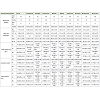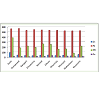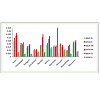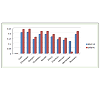Research Article
Quantification of Metal Nutrients in Origanum vulgare L. Collected from North Western Himalayas
Geeta Tewari, Chitra Pande*, Shalini Singh and Charu Singh
Corresponding author: Dr. Chitra Pande, Department of Chemistry, D. S. B. Campus, Kumaun University, Nainital 263 002, India, E-mail: pandechitra@yahoo.in
Citation: Tewari G, Pande C, Singh S, Singh C. Quantification of Metal Nutrients in Origanum vulgare L. Collected from North Western Himalayas. J Chem Applied Biochem. 2015;2(1): 109.
Copyright © 2015 Chitra Pande et al. This is an open access article distributed under the Creative Commons Attribution License, which permits unrestricted use, distribution, and reproduction in any medium, provided the original work is properly cited.
Submission: 13/04/2015; Accepted: 20/05/2015; Published: 30/05/2015
Abstract
Beneficial therapeutic properties are shown by a number of minerals, essential to human nutrition. Many of these nutrients are present in different parts of plants and also have a significant role in biological systems either with organic molecules such as metalloenzymes or independently like redox or catalytic reaction.
The concentration (mg kg-1) of selected trace metals (Fe, Mn, Cu, and Zn) were examined in Origanum vulgare L. collected from ten locations in Uttarakhand by atomic absorption spectrophotometer.
The metal contents in the samples were found at different levels. The mean concentration (mg kg-1) of Zn in plants ranged from 17.250 ± 0.30 to 48.500 ± 1.13collected from Rushi and Mukteshwer respectively while Fe in plants ranged from 234.460 ± 0.49 to 402.630 ± 0.51 mg kg-1 in Origanum collected from Mukteshwer and Champawat respectively. Mean content of Cu in plants was found to be minimum in Origanum from Mukteshwer 6.620 ± 0.91 mg kg-1 and maximum in Origanum from Kilbury (24.120 ± 0.17 mg kg-1). The lowest mean concentration of Mn in plants was observed in Origanum from Mukteshwer (18.590 ± 1.37mg kg-1) and highest from Rushi (60.970 ± 0.86 mg kg-1). Origanum collected from all sites have metal values below PFA limits. These results are useful for the evaluation of the quality of consummate aromatic pants.
Keywords: Origanum vulgare L.; Metal nutrients; Daily intake; Copper; Zinc; Iron; Manganese
Introduction
Minerals have tendency to accumulate in different parts of plants that have some medicinal or therapeutic value. Besides mineral content of plants, metal content has also a significant role to play in biological activity either in combination with organic molecules or independently like redox or catalytic reaction. With the increased awareness of the importance of trace elements on health, a number of reports on the role of trace elements in traditional medicines have been published in India [1,2], China [3,4], Nigeria [5,6], Greece [7] and Egypt [8,9]. Medicinal and aromatic plants are used for controlling diseases such as common colds, malaria, arthritis and ulcers for a long time [10]. Trace metals show very important biological functions and are the component of proteins such as haemoprotein and haemoglobin that play key role in biochemical functions and essential enzyme system even in low levels. Previous studies showed that optimal intakes of macro and micro elements such as sodium, potassium, magnesium, calcium, manganese, copper, zinc and iodine could reduce individual risk factors, including those related to cardiovascular disease for both human beings and animals [11,12]. Trace metal nutrients are essential in amounts, less than 100 mg per day, and represent less than 0.01% of bodyweight. Essential trace elements are zinc (Zn), iron (Fe), silicon (Si), manganese (Mn), copper (Cu), fluoride (F-), iodine (I) and chromium (Cr). Trace elements when present in high amount, causes significant health hazards to human and have become an area of particular concern and high priority in environmental research [13]. Several investigations on trace elemental analysis have been carried out on edible wild plants [14-16] but limited investigations on trace element content of aromatic and medicinal plants were made [17,18] in Uttarakhand. Origanum vulgare L. is used for perfumery, cosmetic preparations and medicines [19].
Therefore, the aim of the present investigation was to determine some micro nutrient content of Origanum vulgare and soils of Uttarakhand having commercial potential. This plant could potentially be either dangerous or useful for humans who are consume this plant or to animals feeding on this economically important plants depending upon its nutrient status.
Materials and Methods
Collection of plant material and soil samples
Fresh plant material of O. vulgare L. along with its soil samples (0-20 cm) were collected in September to November, 2009 from ten locations viz. Dhoulchina (29°37’N, 79°40’E), Champawat (29°36’N: 79°30’E), Dharchula (29°51’00’’N: 80°31’60’’E), Munsiyari (30°04’37”N: 80°23’04”E), Ramgarh (29°23’N: 79°30’E), Kilbury (29°23’N: 79°30’E), Mukteshwar (29°28’N: 79°39’E), Mussoorie (30° 27’ N: 78° 06’ E), Nainital (29°23’N: 79°30’E) and Rushi village (29°23’N: 79°30’E) in Himalaya (Uttarakhand, India). The plants were in full blooming stage. The botanical identification of the specimen was done at Botanical Survey of India, Dehradun (Voucher no.-2036).
Physicochemical properties
The physical properties of the soils from the ten mentioned sites have been determined. These are Soil texture, pH & EC [20], organic carbon by Walkley Black method [21], CEC [22] and WHC (water holding capacity) values (in triplicate) given in Table 1.
Preparation of Soil samples for micronutrient analysis
Well-mixed samples of 2g soils were taken in 250 mL glass conical flasks and digested with 8 mL of aqua regia on a sand bath for 2 hour. After evaporation near to dryness, the samples were dissolved with 10 mL of 2% nitric acid, filtered (Whatman No. 42) and then diluted to 50 mL with distilled water [23]. Blanks were prepared to check for background contamination by reagents used [24].
Preparation of plant samples for micronutrient analysis
The collected plant material were washed sequentially with tap water, 0.1N HCl solution and finally with distilled water. Dry plant tissue was finely ground and wet ashed using HNO3: H2SO4: HClO4 (10:1:4 v/v) [25].
Heavy metal analysis in soil and plant samples
Concentration of Zn, Cu, Mn and Fe in prepared plant and soil samples were analyzed by atomic absorption spectrophotometer ((GBC, Avanta-Sigma, USA).
Data analysis
The daily intake of metals (DIM) was calculated by the following equation:
DIM = |M| x K x IW
Where |M|, K, I and W represent the heavy metal concentrations in plants (mg kg-1), conversion factor, daily intake of vegetables and average body weight, respectively. the conversion factor used to convert fresh green vegetable weight to dry weight was 0.085, as described by Rattan et al., 2005 [26]. The average adult and child body weights were considered to be 55.9 and 32.7 kg, respectively, while average daily vegetable intakes for adult and children were considered to be 0.345 and 0.232 kg/person/day respectively, as reported in literature [27,28].
Results and Discussion
Physicochemical properties
The physical properties of the soils from the ten sites have been determined. The values of pH ranged in a narrow interval 5.31 ± 0.40 to 7.41 ± 0.10 from Dharchula and Rushi respectively. Percentage organic carbon (%OC) in the samples ranges between 0.60 ± 0.30 (Champawat) to 4.20 ± 0.40 (Munsyari). The cation exchange capacity (CEC) of the soil samples ranged between 10.30 ± 0.20 and 38.11 ± 0.30 cmolc kg-1. As shown in Table 1, the soil samples collected from Rushi displayed the highest mean CEC value; those from the Dharchula had the least value. The EC range was from 0.04 ± 0.02 to 0.34 ± 0.02 d Sm-1. This shows that the percentage of soluble salts was maximum in Rushi soil and lowest in Champawat Soil. On the basis of percentage of clay, silt and sand the soils were classified as loamy sand and sandy loam (Table 1).
Metal content in soils
Total four elements (Zn, Cu, Fe and Mn) were determined in the powdered plant and soil samples collected from ten locations in Uttarakhand by Atomic Absorption Spectrophotometer. All the samples were analyzed in triplicates. The concentration of various elements in investigated plants and soils were shown as the mean content ± SD of three samples. Results were calculated on a dry weight basis (mg kg-1). From the study, it was revealed that all the metals were accumulated to greater or lower extents by Origanum species studied.
The metal contents in the tested samples were found at different levels. The mean concentration (mg kg-1) of total Zn in soil ranged from 26.880 ± 1.17 to 91.680 ± 0.430 collected from Mukteshwer and Rushi respectively. Total Fe content in soil ranged from 516.860 ± 4.090 to 564.450 ± 12.87 mg kg-1. The lowest mean concentration of total Mn in soil was observed in Origanum from Mukteshwer (84.150 ± 1.820 mg kg-1) and highest from Rushi (348.020 ± 1.420 mg kg-1)
Mean content of total Cu in soil was observed to be minimum in Origanum from Mukteshwer 10.700 ± 1.750 mg kg-1 and maximum in Origanum from Kilbury (34.680 ± 0.270 mg kg-1). Although Cu is an essential micronutrient for plant growth, it can be more toxic than non-essential Pb when present above the permissible limit in the soil environments [29].
Different metabolic processes are regulated by these micronutrients. Some zinc containing enzymes like carbonic anhydrase and lactate dehydrogenase, are involved in intermediary metabolism processes while superoxide dismutase controls free radical damage [30]. Iron is an essential but potentially hazardous biometal. This metal is required by mammalian cells to control metabolic processes or to accomplish specialized functions [31]. Manganese is an essential metal for plants, participate in several metabolic processes, mainly photosynthesis and as an enzyme antioxidant-cofactor [32] (Figure 1).
Metal content in plants
Total mean content of Zn in Origanum ranged from 17.250 ± 0.300 to 48.500 ± 1.130 from Mukteshwer and Rushi respectively. Zn is not considered to be highly phytotoxic, but high zinc contents in plants may cause the loss of leaves production, whereas low contents may cause deformations of leaves. A plant foliar content of 100 mg kg-1 Zn has been quoted by various authors [15]. The total Fe content in plant ranged from 234.460 ± 0.490 to 402.630 ± 0.510 mg kg-1 in Origanum collected from Mukteshwer and Champawat respectively. The tolerable upper limit of iron for human is 45 mg per day [16]. The lowest mean concentration of total Mn in plants was observed in Origanum from Dhoulchina (18.590 ± 1.370 mg kg-1) and highest from Rushi (60.970 ± 0.860 mg kg-1). Mean content of total Cu in plants were found to be minimum in Origanum from Mukteshwer 6.620 ± 0.910 mg kg-1 and maximum in Origanum from Kilbury (24.120 ± 0.170 mg kg-1) (Figure 2).
Daily intake of metals
In order to evaluate the health risk of any contaminant, it necessary to determine its level by detecting the routes of exposure to the targated organisms. Food chain is the most important pathway to determine the way of exposure to human. The daily intake of metals was evaluated by average plant consumption by both adults and children. The consumption of some plants collected from contaminated sites, showed high capacity of metal accumulation which further transfers these metals to adults and children. The present study indicated that children ingest significant amount of metals as compared to the adult but is nearly free of risk (Figure 3 and 4). The highest intakes of Zn, Cu, Mn and Fe were from the consumption of O. vulgare from Rushi, Dharchula, Kilbury and Champawat respectively for both adults and children.
Conclusions
From the above discussion, it can be concluded that Origanum is good source of biologically important elements that may play a part in the observed therapeutic uses of these plants. Plants from all the ten locations of Uttarakhand were rich in Fe, Mn, Cu and Zn and the metal content in the plants were within the Prevention of Food Adulteration Act (PFA) limits and thus, might play an important role in maintenance of human health.
The heavy metals concentrations were higher in soil samples as compared to plants samples and the reason might be due to strong adsorptive nature of soil. The present study indicates that children ingest significant amount of metals as compared to the adults and are nearly free to risk. The regular monitoring these metals in soils, medicinal plants and in other food items is very important and necessary to prevent bioaccumulation of these metals.
References
- Rao PU (1987) Chemical composition and biological evaluation of debitterized and defatted neem (Azadirachta indica) seed kernel cake. Journal of the American Oil Chemical Society 64: 1348-1351.
- Rajurkar NS, Vinchurkar MS (1992) International Journal of Radiation Applications and Instrumentation. Part A. Applied Radiation and Isotopes 43: 1515-1516.
- Chen KS, Tseng CL, Lin TH (1993) Trace elements in natural drugs determined by INAA. Journal of Radioanalytical and Nuclear Chemistry170: 265-280.
- Wong MK, Tan P, Wee YC (1993) Heavy metals in some Chinese herbal plants. Biological Trace Element Research 36: 135-142.
- Ndekwere CL (1984) Determination of constituent elements in some Nigerian medicinal plants by thermal-neutron activation analysis. Journal of Radioanalytical and Nuclear Chemistry 85: 325-338.
- Anjorin TS, Ikokoh P, Okolo S (2010) Mineral composition of Moringa oleifera leaves pods and seeds from two regions in Abuja, Nigeria. International Journal of Agriculture and Biology 12: 431-434.
- Kanias GD, Loukis A (1987) Determination and correlation of active constituents and trace elements in the medicinal plants Thymus capitatus Hffm. and Link. Analytical Chemistry 327: 355-357.
- Rashed MN (1995) Trace element determination in warm-climate plants by Atomic Absorption Spectroscopy and Ion Selective Electrodes. Journal of Arid Environments 30: 463-478.
- Badri MA, Pulford ID, Springuel I (1996) Supply and accumulation of metals in two Egyptian desert plant species growing onwadi-fill deposits. Journal of Arid Environments 32: 421-429.
- Obiajunwa EI, Adebajo AC, Omobuwajo OR (2002) Essential and trace element contents of some Nigerian medicinal plants. Journal of Radioanalytical and Nuclear Chemistry 252: 473-476.
- Mertz W (1982) Trace minerals and atherosclerosis. Food Processing 41: 2807-2812.
- Sanchez-Castillo CP, Dewey PJS, Aguirre A, Lara JJ, Vaca R, et al. (1998) The mineral content of Mexican fruits and vegetables. Journal of Food Composition and Analysis 11: 340-356.
- Venugopal B, Luckey TD (1988) Metal toxicity in mammals: Chemical toxicity of metal and metalloids Plenum Press, New York.
- Guierrero JLG, Martirey JJG, Irosa MET (1998) Mineral nutrient composition of edible wild plants. Journal of Food Composition and Analysis 11: 322-328.
- Gupta K, Wagle DS (1998) Nutritional and antinutritional factors of green leafy vegetables. J Agric Food Chem 36: 472-474.
- Özcan M, Akgul A (1998) Influence of species, harvest date and size on composition of capers (Capparis spp.) flower buds. Foof/Nahrung, 42: 102-105.
- Khanum F, Sudarshan, krishna, KR, Semwal AD, Vishwanathan KR (2001) Proximate composition and mineral contents of spices. The Indian Journal of Nutrition and Dietetics 38: 93-97.
- Okeke EC (1998) The Use and Chemical Content of Some Indigenous Nigerian Spices. Journal of Herbs, Spices & Medicinal Plants 5: 51-63.
- Manandhar NP (1992) Folklore medicine of Dhading district, Nepal. Fitoterapia 63: 163-177.
- Jackson ML (1958) Soil chemical analysis, Prentice Hall Inc., Englewood Cliffs, NJ.
- Walkley A, Black IA (1934) An examination of the digestion method for determining organic carbon in soils: Effect of variations in digestion conditions and of inorganic soil constituents. Soil Science 37: 29-38.
- Bower CA, Reitemeter RF, Fireman M (1952) Exchangeable cation analysis of saline and alkali soils. Soil Science 7: 251-262.
- Chen M, Ma LQ (2001) Comparison of three aqua regia digestion methods for twenty Florida soils. Soil Science SocIety of American Journal 65: 491-499..
- Piper CS (1942) Soil and plant analysis. The University of Adelaide, Adelaide, Australia.
- Rattan RK, Datta SP, Chhonkar PK, Suribabu K, Singh AK (2005) Longterm impact of irrigation with sewage effluents on heavy metal contents in soils, crops and ground water - a case study. Agriculture, Ecosystem and Environment 109: 310-322.
- Ge KY (1992) The status of nutrient and metal on Chinese in the 1990s Beings people’s Hygiene Press, pp. 415-434.
- Wang X, Sato T, Xing B, Tao S (2005) Health risks of heavy metals to the general public in Tianjin, China via consumption of vegetables and fish. Science of the Total Environment 350: 28-37.
- An YJ (2006) Assessment of comparative toxicities of lead and copper using plant assay. Chemosphere 62: 1359-1365.
- Vallee BL, Falchuk KH (1993) The biochemical basis of Zinc physiology. Physiol Rev 73: 79-118.
- Wang J, Pantopoulos K (2011) Regulation of cellular iron metabolism. Biochem J 434: 365-381.
- Millaleo R, Reyes-Diaz M, Ivanov AG, Mora ML, Alberdi M (2010) Manganese as essential and toxic element for plants: Transport, accumulation and resistance mechanisms. Journal of Soil Science and Plant Nutrition 10: 470-481.





